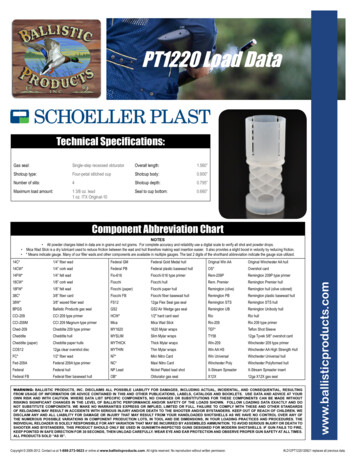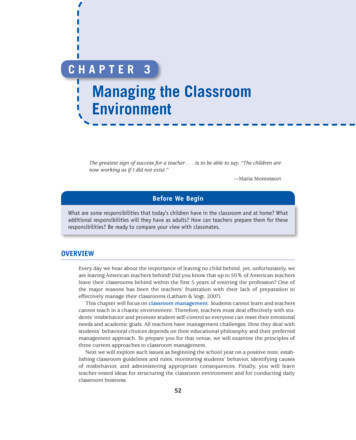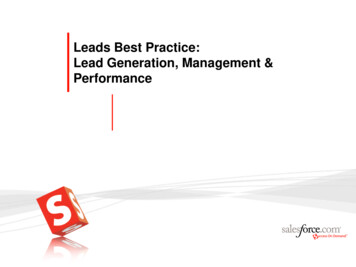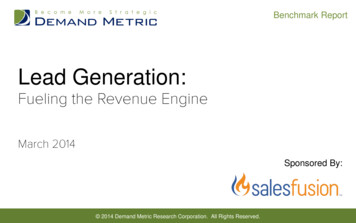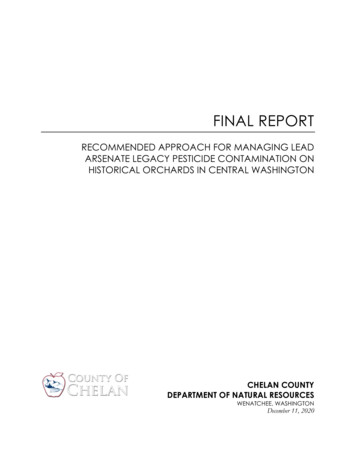
Transcription
FINAL REPORTRECOMMENDED APPROACH FOR MANAGING LEADARSENATE LEGACY PESTICIDE CONTAMINATION ONHISTORICAL ORCHARDS IN CENTRAL WASHINGTONCHELAN COUNTYDEPARTMENT OF NATURAL RESOURCESWENATCHEE, WASHINGTONDecember 11, 2020
ACKNOWLEDGMENTSLEGACY PESTICIDE WORKING GROUPClint Adamson, Pleasant Ridge ConstructionLori Barnett, City of East WenatcheeSteve Bishop, Premier One PropertiesJim Blair, North Meridian Title and Escrow, LLCMark Botello, Douglas CountyLilian Bravo, Yakima Health DistrictJoan Davenport, City of YakimaJoseph Calhoun, City of YakimaJon DeVaney, Washington State Tree FruitAssociationGlen Devries, City of WenatcheeDean Emanuels, Washington Trust BankDoug England, Chelan CountyPete Fraley, Ogden Murphy WallaceCraig Gildroy, City of ChelanKeith Goehner, Representative 12th LegislativeDistrictByron Gumz, Yakima CountyRob Jammerman, City of WenatcheePaul Jewell, WSACHank Lewis, Local homebuilding interestsCurtis Lillquist, Douglas CountyRyan K. Mathews, CIH, CHMM, FulcrumEnvironmental Consulting, Inc.Jake Mayson, Central Washington HomebuildersAssociationDeb Miller, Action Health PartnersDon Mounter, Pipkin ConstructionDereck Nelson, DH ConstructionMike Shuttleworth, Yakima Valley Council ofGovernmentsKyle Steinburg, Douglas CountyJudy Warnick, Senator 13th Legislative DistrictCONSULTING TEAMMaul Foster & Alongi, Inc.FUNDINGWashington State Department of Ecology in partnership with the Chelan County Department ofNatural ResourcesR:\1938.01 Chelan County Dept of Natural Resources\Document\01 2020.12.11 Draft Final Report\Rd Final Draft LPWG 12172020.docxPAGE II
DPROCESSQUICK REFERENCE GUIDE42AFFECTED DEVELOPMENT PROJECTSINTRODUCTIONCOMMONLY AFFECTED DEVELOPMENT PROJECTSDEVELOPMENT PROCESSTYPICAL COSTS5667103RECOMMENDED APPROACHINTRODUCTIONPUBLIC OUTREACH AND EDUCATIONDEVELOPMENT OF A MODEL REMEDYINTEGRATED DEVELOPMENT PERMIT REVIEW PROCESSSOIL MANAGEMENTADDITIONAL CONSIDERATIONSRESPONSIBILITIES TABLE1223111524254COMPARATIVE ANALYSISINTRODUCTIONDEVELOPMENT SCENARIOSCOMPARATIVE ANALYSIS282929305PUBLIC EDUCATION AND OUTREACH STRATEGYINTRODUCTIONGOALSPROJECT TIMELINEEDUCATION AND OUTREACH SEQUENCETOOLS34AUDIENCES (BROAD GROUPS)WAYS TO GET ENGAGED32333333343535APPENDIX ALOCAL GOVERNMENT LAND USE PERMITTING PROCESSESAPPENDIX BMODEL REMEDY RECOMMENDATIONSAPPENDIX CSAMPLE SEPA COMMENTS & INFORMATIONAL LETTERSAPPENDIX DSOIL BANK COST ESTIMATESAPPENDIX ER:\1938.01 Chelan County Dept of Natural Resources\Document\01 2020.12.11 Draft Final Report\Rd Final Draft LPWG 12172020.docxPAGE III
DETAILED COMPARATIVE SCENARIO COST ESTIMATESAPPENDIX FEXAMPLE CONDITIONS OF APPROVALR:\1938.01 Chelan County Dept of Natural Resources\Document\01 2020.12.11 Draft Final Report\Rd Final Draft LPWG 12172020.docxPAGE IV
1INTRODUCTIONTree fruit orchards have been an important economic and cultural resource in Central Washingtoncommunities since the late 1800s. Population growth and increasing demand for housing have resultedin conversion of historical orchard sites to other, nonagricultural uses, including residentialdevelopment. Historical application of lead arsenate (LA) pesticides on tree fruit orchards has resultedin the accumulation of lead and arsenic in shallow soil at concentrations above State cleanup levels.These are levels that may be harmful to human health when these properties are used for activitiesother than agricultural or industrial land uses. This report outlines a recommended approach formanaging and mitigating LA pesticide soil contamination, as well as educating impacted people andcommunities about the issue. The recommendations are intended to be consistent with theWashington State Model Toxics Control Act (MTCA).R:\1938.01 Chelan County Dept of Natural Resources\Document\01 2020.12.11 Draft Final Report\Rd Final Draft LPWG 12172020.docxPAGE 1
BackgroundTree fruit orchards have been an important economic and cultural resource in Central Washingtoncommunities since the late 1800s. Until approximately 1950, agricultural activities at tree fruitorchards often included the use of LA pesticides to mitigate insect damage. In some cases, historicalapplication of LA pesticides has resulted in shallow-soil concentrations of lead and arsenic thatexceed Washington State cleanup levels. According to the Washington State Agricultural Censusfrom 1947, compiled by the Washington State Department of Ecology (Ecology), nearly 188,000acres of land in Washington have been historical orchard areas subject to application of LApesticides, and are therefore considered potentially contaminated by lead and arsenic. Of those areas,approximately 115,000 acres of potentially impactedtree fruit orchard lands are in Yakima, Chelan, Douglas,Okanogan, and Benton counties.Growth in these counties has resulted in the transitionof tree fruit orchards to nonagricultural uses (e.g.,residential or commercial), increasing the potential formore frequent, direct exposure to soil that may haveelevated concentrations of lead and arsenic that couldadversely impact human health. In many cases, theconcentration of lead and arsenic in the historicalorchard soil exceeds the MTCA cleanup levels for thesecompounds. MTCA requires appropriate assessment,notification, and cleanup tools to ensure sufficientprotection of potential, current, and future residentsliving in historical tree fruit orchard areas where leadand arsenic may be present at levels of concern.ProcessThe Legacy Pesticide Working Group (LPWG), formed in December 2019, includes a diverse groupof stakeholders, representing private and public interests, throughout Central Washington. Asdescribed on Ecology’s website for this effort, the purpose of the LPWG is “to address the complexissues surrounding lead and arsenic contamination on former orchard lands.”The primary objectives for the working group were: Creating a process for evaluation of all properties. Notifying buyers and current homeowners concerning the specifics of LA pesticidecontamination on their properties. Identifying actions that meet Ecology’s cleanup regulations. Creating a broad-based strategy for educating the public about managing the risk from LApesticide contamination.R:\1938.01 Chelan County Dept of Natural Resources\Document\01 2020.12.11 Draft Final Report\Rd Final Draft LPWG 12172020.docxPAGE 2
This final report has been prepared in support of the LPWG’s efforts and outlines a finalrecommended process to achieve these primary objectives. Following the completion of the workelements outlined below, Ecology will continue to develop and implement the activities discussed inthis plan.Legacy Pesticide Working Group—Work PlanFeb. Mar. Apr. MayWorking Group MeetingsJun.2020Jul.Aug.Sep.Oct.Nov.Dec.MFA TasksBackground & Research Assessment ReportAnalysis & Final ReportPublic Outreach Strategy &MaterialsR:\1938.01 Chelan County Dept of Natural Resources\Document\01 2020.12.11 Draft Final Report\Rd Final Draft LPWG 12172020.docxPAGE 3
QUICK REFERENCE GUIDEI want to.Relevant report sectionsUnderstand the issue of LA pesticidecontaminationFind information in the introduction of this report and online ioncleanup/Cleanup-sites/Former-orchard-landsFind out if a property has LA pesticidecontaminationCheck your property address using the interactive webpage at (TBD)Understand options to manage LApesticide contaminationReview Figure 3-3 Cleanup Technology Comparison and page 11 forBest Management PracticesUnderstand my responsibilities forcleanupReview Figure 3-2 Property Sampling Decision TreeUnderstand my role in the permitting,land development and transactionprocessReview chapters 2 and 3Understand what Ecology has plannedfor community outreachReview chapter 5 of this reportUnderstand the health risk associatedwith LA pesticide contaminationReview chapter 2 of the Background Report developed in August 2020Understand the relevant federal andstate regulations regarding LApesticide contaminationReview chapter 3 of the Background Report developed in August 2020Understand how soil sampling worksand what I can do about itReview chapter 4 of the Background Report developed in August 2020Review what other agencies have doneabout similar contamination issuesReview chapter 5 of the Background Report developed in August 2020R:\1938.01 Chelan County Dept of Natural Resources\Document\01 2020.12.11 Draft Final Report\Rd Final Draft LPWG 12172020.docxPAGE 4
2AFFECTED DEVELOPMENT PROJECTSThis chapter provides typical scenarios for development project types that can take place in historical orchard areas inCentral Washington. Scenarios show similarities across jurisdictions and points in permit review processes that willallow for consistent cleanup of LA pesticide.Local planners and developers were interviewed to provide background for costs, permitting, and cleanup strategies thatcomply with MTCA.R:\1938.01 Chelan County Dept of Natural Resources\Document\01 2020.12.11 Draft Final Report\Rd Final Draft LPWG 12172020.docxPAGE 5
IntroductionGenerally, there are two situations - 1) existing developed properties and 2) proposed newdevelopment projects - where addressing the issue of lead and arsenic contamination from historicalorchard practices will be required.Existing single-family homes, apartment buildings, and school and park playgrounds and playfieldsalready built in historical orchard areas are examples of developed properties that may have lead andarsenic contamination in shallow soils. Many existing schools and parks in Central Washington haveeither completed or will implement soil cleanup projects, often through available funding programssponsored by Ecology.Current residents in historical orchard areas will be one of the primary targets of a public educationand outreach strategy being developed through this effort. This strategy will provide detailedinformation to existing residents on best management practices (BMPs) to lower the risk of impactsfrom any lead and arsenic contamination that may exist, as well as identifying Ecology resources thatcan be used to help them clean up their property, if they choose to do so.New development on historical orchard areas may include a variety of activities including commercialand industrial land uses as well as public school and park projects that will follow the current cleanupprocesses available in MTCA. New residential development on historical orchards, including singlefamily home construction, multifamily development projects and residential subdivisions, are theprimary subject of the alternative MTCA compliance approach described in this report.This chapter summarizes typical residential development projects and permitting processes, focusingon residential subdivisions, single family home construction, and multifamily development projects.MFA conducted a series of interviews with developers and local government planning staff tounderstand the perspectives of both developers and regulators. Insights from these interviews areintegrated throughout this chapter. A comparison table of the interviewed local jurisdictions’development permit review processes is available in Appendix A. In addition to conducting theinterviews, several recently completed and proposed development projects were reviewed todetermine the typical scale and type of residential development occurring in the region.Commonly Affected Development ProjectsThis report examines four scenarios based on residential development types that are common inCentral Washington and that may be impacted by LA pesticides: large subdivisions, small subdivisions,new multifamily developments, and new single-family home construction. Based on interviews withdevelopers and a review of recently completed and proposed projects, typical scenarios were createdfor each project type, presented below.R:\1938.01 Chelan County Dept of Natural Resources\Document\01 2020.12.11 Draft Final Report\Rd Final Draft LPWG 12172020.docxPAGE 6
TYPICAL DEVELOPMENT PROJECTS AND SEPA REQUIREMENTSProject typeLot Size (acres)Individual LotSize afterSubdivisionNumber ofLots/UnitsTypical Unit SizeSubject toSEPA Review?Large subdivisions300.31002,200 squarefeet3 bedroomsYesSmall subdivisions2.40.382,200 squarefeet3 bedroomsNoNew multifamilydevelopment2100800 square feetStudio2 bedroomsDependenton jurisdictionNew single-family homeconstruction0.312,200 squarefeet3 bedroomsNoDevelopment ProcessThis chapter provides an overview of the typical development project planning and permittingprocess, from initial due diligence to issuance of occupancy permits, based on conversations with bothdevelopers and local planning staff. In addition to the due diligence conducted by the developer priorto beginning a project, there are two basic permitting processes during which cleanup of contaminatedsoil is addressed: during the subdivision of a larger parcel into smaller lots for individual sale, andduring construction of the residential structure.For simplicity, this report describes projects where a single developer is responsible for not onlycreating the subdivision, but also constructing all of the housing units. However, it is common forone developer to acquire and subdivide property, and then to sell individual lots to differentcontractors/builders that continue with the individual construction process, eventually selling homesto a new homeowner or leasing apartments to residents. Regardless of the number of developersinvolved, the basic permit and review requirements remain the same, however there would likely bean additional round of due diligence conducted by the contractor/builder prior to the sale of thesubdivided lot(s).DUE DILIGENCEEach type of residential development begins with a developer identifying a suitable property for theirproject idea. In this early phase of the project, the developer conducts due diligence to determine if itis feasible, given any constraints of the site such as zoning or site features such as size and slopes. Thedeveloper also creates an estimate of the number of housing units that can fit on the site and of thecost for site preparation and construction and the potential return on investment, once the units aresold or leased. If the developer believes that the project is feasible or that it “pencils,” they typicallywork to control the site by either purchasing it or negotiating a purchase agreement or purchase optionthat is dependent on completing further design or successful permitting processes.R:\1938.01 Chelan County Dept of Natural Resources\Document\01 2020.12.11 Draft Final Report\Rd Final Draft LPWG 12172020.docxPAGE 7
PERMITTING PROCESSMost jurisdictions in Central Washington, except Okanogan County and its cities, implement theirdevelopment permit review processes consistent with the requirements of Washington State’s LocalProject Review (Revised Code of Washington 36.70B). These processes typically include the followingreview steps.Preapplication: Usually involves a meeting that is conducted before submittal of application materials.It often includes the project proponent and various departments from the jurisdiction responsible forauthorizing the permit, as well as other, outside agencies that may have permits or regulationsapplicable to a project proposal. This meeting allows the project proponent to discuss their projectand gather information about what may be required for their proposal, including whether additionalstudies may be required.Application review: Once a project proponent decides to submit their application materials, the formalreview process begins. Depending on the complexity of the proposal, and after the application isdetermined to be complete and ready for processing, there may be a comment period that thejurisdiction uses to collect comments from internal departments, other agencies, and the public. Forprojects that require a State Environmental Policy Act (SEPA) review process, this comment periodis also when comments are gathered following a Determination of Nonsignificance (DNS). Thejurisdiction gathers the comments received, evaluates the proposal for compliance with applicableregulations, and prepares either a decision document for those projects that do not require a publichearing, or a staff report that is intended to support the decisionmaker conducting the public hearing.Public hearing, if required: The purpose of a public hearing is to allow another opportunity for reviewof the proposal, and for interested parties, including the general public, to provide comments aboutthe development project before a final decision is made. The decisionmaker considers the staff report,as well as the testimony provided by interested parties at the public hearing and develops a decision.Decision: For a significant number of development permit proposals, the final approval decision willinclude conditions with which the project proponent must comply. For example, for subdivisionproposals (creating additional building lots), this typically includes development of on-siteinfrastructure and utilities (roads, stormwater facilities, water, sewer, power, and telecommunications),and in some cases additional, off-site improvements may be required. For other types of land usepermits, conditions of approval may obligate the project proponent to change different aspects oftheir project or require them to conduct their activities in a certain manner to reduce potentiallynegative impacts to surrounding properties.R:\1938.01 Chelan County Dept of Natural Resources\Document\01 2020.12.11 Draft Final Report\Rd Final Draft LPWG 12172020.docxPAGE 8
Residential SubdivisionsIf a developer is planning a project on a largeparcel that will have to be divided into smallerlots, they will need to go through a subdivisionprocess. There are two types of processes: shortsubdivisions and major subdivisions. Dependingon the permitting jurisdiction, subdivisions of upto four or up to nine lots can go through a shortsubdivision process, which is typically exemptfrom SEPA review. Subdivisions creating five orten lots or more go through a major subdivisionprocess, including a required SEPA review. Bothtypes of subdivision processes include thepreapplication and application review stepsdescribed above and successful applications resultin a preliminary approval. The preliminaryapproval includes a series of required conditions,including the necessary site infrastructureimprovements such as access roads and theextension of utilities to serve the proposed newlots.Following preliminary approval, the developercompletes the necessary survey work andconstruction of site improvements that define andcreate the new lots. Once the preliminaryapproval conditions have been completed, thedeveloper can apply for final approval of thesubdivision. The local government reviews theapplication to ensure that the conditions havebeen satisfied and issues a final approval decision,which allows the new lots to be recorded as legallots that can then be sold individually. Thetimeline for this process varies greatly, dependingon the size of the project, the completeness of theapplication materials submitted by the developer,and how quickly the preliminary conditions ofapproval are satisfied. One local planning staffmember estimated that a short subdivision cantake between six and eight months, while majorsubdivisions take one and one-half to three yearsto complete.R:\1938.01 Chelan County Dept of Natural Resources\Document\01 2020.12.11 Draft Final Report\Rd Final Draft LPWG 12172020.docxPAGE 9
Building PermitsOnce a subdivision of land is complete,permits for individual structures arerequired. For a single-family residence, abuilding permit is required. Multifamilydevelopment projects also requirebuilding permits, and in some instancesadditional land use permits, such as aconditional use permit, may be necessarybefore the building permit can be issued.Multifamily projects may also be subjectto a SEPA review, based on the numberof units being proposed. Each city andcounty establishes its threshold (basedon a range established in the state law)that determines whether or not a SEPAreview is required. These SEPAthresholds for multifamily projectsrange from four or more units in the Cityof East Wenatchee to 61 or more unitsin the City of Yakima. So, a 50-unitmultifamily development project in EastWenatchee would be required toundergo SEPA review, but a similarproject in Yakima would not.Once the review of a completedapplication has been conducted, thejurisdiction issues a building permit. Theconstruction authorized by a buildingpermit requires multiple inspectionsthroughout the development process toensure compliance with building iredinspectionsarecomplete,thejurisdiction issues a certificate ofoccupancy. This marks the end of thepermit process and allows the lease orsale of the unit to the new inhabitants.Typical CostsDevelopers provided ballpark estimates of typical costs associated with residential developmentscenarios, including property acquisition, site preparation, and building construction in Yakima andR:\1938.01 Chelan County Dept of Natural Resources\Document\01 2020.12.11 Draft Final Report\Rd Final Draft LPWG 12172020.docxPAGE 10
Chelan County. Site preparation encompasses all activities required to prepare the site forconstruction, including development of infrastructure such as access roads and utilities, grading, offsite mitigation if needed, permitting, and holding costs while work is under way.Land AcquisitionLand cost/acres 80,000Site PreparationCost/10,000 SF lot 45,000Single Family Home ConstructionCost per SF 150Average Unit SF2,200Construction Cost/unit 330,000Multifamily ConstructionCost per SFAverage Unit SFConstruction Cost/unit ? ?,?R:\1938.01 Chelan County Dept of Natural Resources\Document\01 2020.12.11 Draft Final Report\Rd Final Draft LPWG 12172020.docxPAGE 11
3RECOMMENDED APPROACHBased on the findings outlined in Chapter 2, this Chapter reviews the recommended approach for a uniformly appliedand streamlined process for cleanup and/or management of lead and arsenic contamination. The goal of this process isto integrate the assessment and cleanup requirements of MTCA with the residential development permit process.R:\1938.01 Chelan County Dept of Natural Resources\Document\01 2020.12.11 Draft Final Report\Rd Final Draft LPWG 12172020.docxPAGE 1
IntroductionBased on study research, review of applicable land use and environmental regulations, and on inputfrom the LPWG and Ecology, this report outlines a recommended approach for managing potentialLA pesticide contamination on historical orchard areas in Central Washington. The recommendedapproach seeks to integrate required components of MTCA related to investigating, cleaning up, andmanaging LA pesticide contamination with the process of permitting and constructing developmentprojects.The recommended approach for managing potential LA pesticide contamination on historical orchardareas in Central Washington presented below includes four primary components:Public education and outreach, including targeted outreach to people throughout Central Washington,including those who may be living in existing homes, including apartments, that may be located onhistorical orchard propertiesDevelopment of a Model Remedy pursuant to MTCA that outlines soil sampling and soil cleanup remediesthat are preapproved by Ecology and that, if utilized in a development project, will result incertification that cleanup under MTCA has been satisfiedImplementation of an integrated development permit review process that clearly outlines how and when therecommended Model Remedy components are considered during the local government land use andbuilding permit processes for residential development projects, including single-family homeconstruction, residential subdivisions, and multifamily developments1Development of soil banks in different urban areas throughout Central Washington to either facilitate theavailability of clean soil for cleanup technologies, provide approved locations for disposal ofcontaminated soil, establish facilities to treat and clean contaminated soil, or create facilities thatprovide a combination of these services based on the needs of the different communities.Public Outreach and EducationAddressing the issue of potential LA pesticide contamination on properties that have already beendeveloped will rely heavily on a robust public education and outreach strategy. The use of lead arsenateas a pesticide was widespread in Central Washington, however, the risks associated with exposure tothese contaminants can be significantly reduced if homeowners implement appropriate bestmanagement practices (BMPs). It is important to ensure that homeowners and apartment dwellerscurrently living in owner-occupied and rented housing have access to and knowledge of thesepractices, some of which are listed below. Chapter 5 of this report discusses in detail the publiceducation and outreach strategy that has been developed to support this component of therecommended approach.1Evaluation of commercial, industrial, public school and public park projects is anticipated to continue through thecurrently available administrative pathways identified in MTCA.R:\1938.01 Chelan County Dept of Natural Resources\Document\01 2020.12.11 Draft Final Report\Rd Final Draft LPWG 12172020.docxPAGE 2
The following homeowner BMPs will help to prevent exposure to LA pesticide residues in soil. Use raised beds with clean, imported soil for fruit and vegetable gardens.Ensure grass layer is kept up so no bare patches of soil are presentWash all fruits and vegetables before eating.Wash hands with soap after working or playing in the dirt.Remove shoes before entering your home.Wash children’s toys and pacifiers frequently.Wear shoes and gloves when gardening and working outdoors.Wash dirt off pets frequently.Create children’s play areas (for example, raised sandboxes or rubber mats below play areas).Vacuum and dust your home at least weekly.Development of a Model RemedyEcology has several existing administrative pathways by which a contaminated site is evaluated andcleaned up under MTCA. Figure 3-1 below provides a general summary of existing formal andinformal pathways. Formal pathways typically years to complete and result in significant costs becausethey require extensive Ecology involvement, as well as consulting and attorney fees. Informalpathways are designed to be completed quickly and at a lower cost, but without a certification thatcleanup is complete.For purposes of this study, it is anticipated that existing regulatory cleanup pathways will continue toaddress commercial and industrial projects, as well as public school and park facilities. As summarizedbelow and described in Appendix B, a new model remedy to address LA contamination on historicalorchards in Central Washington is being recommended for new residential development.R:\1938.01 Chelan County Dept of Natural Resources\Document\01 2020.12.11 Draft Final Report\Rd Final Draft LPWG 12172020.docxPAGE 3
Where there are routine types of cleanup projects, with common features and lower risk to humanhealth and the environment, MTCA allows for development of specific model remedies. MTCAdefines model remedies as: “a set of technologies, procedures, and monitoring protocols identified byEcology for use in routine types of cleanup projects at facilities that have common features and lowerrisk to human health and the environment.” Because potential contamination of shallow soils fromLA pesticides on historical orchard properties is widespread and consistent, the recommendedapproach outlined in this study is based on Ecology developing and implementing a specific LApesticide Model Remedy for historical orchard areas in Central Washington.The recommended Model Remedy (detailed information is provided in Appendix B) is intended toaccomplish the following: Creation of defined, Ecology-approved investigation and cleanup approaches that can beefficiently applied during development Provision of a framework that requires minimal Ecology oversight yet allows for Ecologyengagement if requestedR:\1938.01 Chelan County Dept of Natural Resources\Document\01 2020.12.11 Draft Final Report\Rd Final Draft LPWG 12172020.docxPAGE 4
Limiting delays associated with investigation, cleanup selection, and permitting for new residentialdevelopment projects Minimization of costs associated with MTCA compliance related to Ecology oversight and/orconsultant fees Allowing for ongoing homeowner/resident notification and awareness of not only the potentialexistence of LA pesticide contamination, but also of cleanup remedies and BMPs (for residentsand during construction activities) to help manage potential contaminationPROPOSED MODEL REMEDY GUIDANCEThe following information summarizes the detailed recommendations in Appendix B regarding thetechnical content that should be included in the new Model Remedy. It is recommended that Ecologyprepare a comprehensive document that summarizes the recommended approach and includesguidance on the following primary components: Investigation process Cleanup process Potential permits Construction BMPs BMPs for existing developments Cleanup notificationThe figures provided below are visual representations of several of these recommended ModelRemedy components, and are intended to be used in summary, nontechnical guidance documents tobe provided to applicants and project proponents. Ideally, the summary guidance documents will notonly be provided on Ecology-sponsored media platforms but will also be extensively used by localgovernments as they interact with applicants, particularly early on in the due diligence stage of aproposed project.Figure 3-2 outlines the proposed fram
Pete Fraley, Ogden Murphy Wallace Craig Gildroy, City of Chelan Keith Goehner, Representative 12th Legislative . Tree fruit orchards have been an important economic and cultural resource in Central Washington . Existing single-family homes, apartment buil





